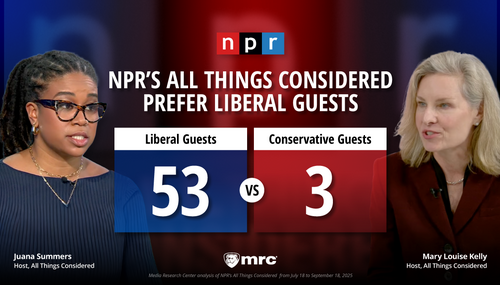For years, government watchdog groups have chronicled numerous instances of waste and abuse — at the very least — at the Centers for Disease Control and its National Institutes for Health.
An establishment press corps doing its job, upon hearing the director of the National Institutes for Health claim that "if we had not gone through our 10-year slide in research support, we probably would have had a vaccine" for Ebola by now, and especially upon hearing leftist poltiticians then claim that it's all Republicans' fault, would look into whether part of the problem might be poor bureacratic stewardship. But they're not doing their job.
While a search at the Associated Press's national site on CDC returns 50 items, a search on "CDC waste" (not in quotes) returns only one — and it only briefly addresses medical waste management. Searches on "National Institutes for Health" and "National Institutes for Health waste" return three and zero results, respectively.
At Google News, an 11:20 PM search search on "NIH" (past week, sorted by date, hiding duplicates) returned 488 items, roughly a couple of hundered of which relate to ebola. A search on "NIH waste" returned 15. Most of them are from center-right news sources. The Huffington Post has two entries whose purpose is ridicule those who are sensibly decrying waste and misguided priorities.
About the federal government as a whole, the late Senator Everett Dirksen once said, "A billion here, a billion there, pretty soon, you're talking real money." In a $30 billion agency with far less in discretionary funding, it doesn't take many millions of wasteful spending to have a negative impact. Thus, the following only partial list of items identified at several outlets during the past several days are absolutely relevant to the discussion. Pretending otherwise is irresponsible.
Here we go (bolded dollar amounts are mine).
First, from a Monday evening Investor's Business Daily editorial:
The CDC's budget today is 25% bigger than it was in 2008 and 188% bigger than in 2000. The NIH budget has been flat for the past few years, but at a level that's more than double what it was 14 years ago. Plus, spending at both of these agencies has actually been higher than President Obama himself proposed ...
... Even if there has been some cutting here and there at these agencies, it's not as if there isn't plenty of fat to trim.
If the NIH was really so concerned about developing an Ebola vaccine, for example, it could have directed more grant money to that effort, rather than wasting it researching such things as diseases among male sex workers in Peru ($400,000), ... and sexual attraction among fruit flies (nearly $1 million).
The CDC isn't much better at husbanding its resources. A few years ago, it dumped $106 million into a swanky visitors' center in Atlanta, even though it already had one. It bought $10 million worth of furniture for its lavish new headquarters and spent $1.7 million to advise Hollywood on medical plots.
Yes, the federal government has blown it on Ebola. But that's not because the relevant agencies have too little money to spend.
Now, via NewsBusters commenter Gary Hall:
- a $702,558 grant for the study of the impact of televisions and gas generators on villages in Vietnam.
- $175,587 to the University of Kentucky to study the impact of cocaine on the sex drive of Japanese quail.
- $55,382 to study hookah smoking in Jordan.
- $592,527 to study why chimpanzees throw objects.
- A year ago there were news reports about a $509,840 grant from NIH to pay for a study that will send text messages in “gay lingo” to meth-heads.
Joseph Rossell at NewsBusters cited the following items in a post yesterday:
Based on the plethora of other wasteful research projects NIH spent grant money on, an Ebola vaccine certainly did not appear to be a high priority. Forbes published a sampling of 18 wasteful programs paid for by NIH as of October, 2012. This research ranged from a study on “Massage in Rabbits” (costing taxpayers $386,000) to numerous studies exploring the effects of meditation (costing hundreds of thousands of dollars each).
Forbes also reported that NIH spent $31 million on a decade-long study of an experimental heart therapy, despite “the probability of the study yielding usable – let alone clinically important — results approached zero.”
Finally, here are some examples cited by Eric Boehm at Watchdog.org:
The CDC, for example, was busted in 2007 by Oklahoma Republican U.S. Sen. Tom Coburn’s office for a litany of questionable spending decisions.
... Though the agency spent more than $2.6 billion on grants for HIV and AIDS research over five years, the CDC acknowledged that many of those grants “have no objectives” or were otherwise useless. They kept funding them anyway.
“Many times the answer is to spend more money instead of redirecting the money or eliminating the waste,” Thomas Schatz, president of Citizens Against Government Waste, a nonprofit that tracks poor spending decisions by Congress and the federal bureaucracy, told Watchdog.org this week. “Programs that are completely ineffective might get cut by a few percentage points or something, but the wasteful spending still exists.”
... Since being embarrassed by Coburn’s report, the CDC’s track record has not exactly improved.
The agency has received more than $3 billion from a new research fund created by the Affordable Care Act, but has spent only $180 million of that bounty on researching dangerous diseases.
Instead, it has budgeted millions of dollars each year for community grants aimed at convincing Americans to make smart choices about their health — essentially, taxpayer-funded advertising telling you to put down that giant soda and eat more salad.
Keep in mind that items noted, along with many others documented elsewhere, represent only what watchdog groups have been able to find. Imagine how much other waste and abuse — if not outright fraud — has likely gone uncovered.
Sadly, the establishment press rarely takes an interest in government waste, fraud and abuse. Their logic is that the bigger government gets the better — regardless of how well or poorly it performs its designated functions.
Cross-posted at BizzyBlog.com.




